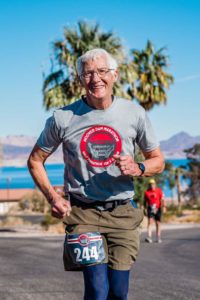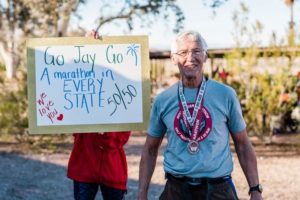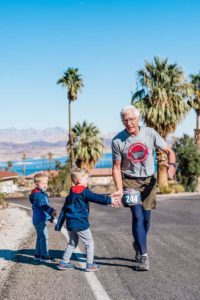By Tom Travis
From the Great Wall of China to the Hoover Dam, Ortonville resident Jay Cummings, 76, experiences life 26 miles at a time — again and again. A retired United Church of Christ minister, he’s a devoted marathon runner who finds the discipline of his chosen sport to be good for his body and spirit — and he has no plans to quit.
Since 1992, when he took up marathon running to try to quit smoking, he’s averaged two marathons a year. After he succeeded at quitting smoking, he tackled a new goal: running a marathon in all 50 states. He completed that goal in 2021 in a marathon at the Hoover Dam in Boulder City, CO. Some of the other cities where Jay has completed marathons are: Tulsa, OK; Collins, CO; Orlando FL; Traverse City, MI, Chicago, IL; Myrtle Beach, FL; Sioux Falls, ND; Atlanta, GA; and on the Island of Hawaii.
The Great Wall marathon cost $500 to register. The marathon organizers suggested the runners train on steps as most of the Great Wall is made up of steps. Jay found an eight-story building in Jackson, where he lived at the time, and ran the steps inside the building to train. Cummings says the course along the Great Wall took runners on portions of the Great Wall then into a nearby village then back on the Great Wall.
It’s a mental, as well as a physical experience, he says. “My brother sent me Jeff Galloway’s book on running for Christmas in 1999. In the book he said, ‘anyone could run a marathon if they went through the training.’ He told about his dad running the Boston Marathon in his 50’s. I was 52 at the time so I started training to see if I could. I ran my first marathon in Chicago in 2000 with 35,000 runners.”
“My mind goes in all kinds of directions. I enjoy the scenery, running on country roads and trails of a county park…observing some sand cranes, a couple of deer, a rabbit and other people running and walking. A couple pushing their baby in a carriage, dogs running and beautiful flowers,” Cummings says.

Marathon runner, Jay Cummings, approaching the finish-line of his 50th U.S. marathon. (Photo submitted by Jay Cummings)

Jay’s family created a sign celebrating his completing the 50th marathon. (Photo submitted by Jay Cummings)
The marathon race has become popular in the 20th century after first being created for the 1896 Athens Olympics. The Ancient Olympics never included long distance running. However, there are ancient roots to the race. As explained in history.com, “The idea for the modern marathon was inspired by the legend of an ancient Greek messenger who raced from the site of Marathon to Athens, a distance of about 40 kilometers, or nearly 25 miles, with the news of an important Greek victory over an invading army of Persians in 490 B.C. After making his announcement, the exhausted messenger collapsed and died.”
Fortunately, Cummings has always survived.
Cummings says he chooses to run by himself with no running partner. He said he used to run with a friend but she was diagnosed with cancer several years ago and was unable to continue running. Jay’s wife Leslie, supports Jay from the sidelines. Sometimes a daughter and grandson will, on occasion, join in a race with their dad/grandpa.
Cummings describes a calculated and statistical process to his training and actual running of a race. “I check my pace from time to time as I run. Because I am working on maintaining my projected marathon pace for 10 of the miles. I focus on my breathing, staying relaxed and my form. I take my pulse first thing in the morning. I weigh myself (if possible). I drink a glass of water, take a multipurpose vitamin, magnesium and eat a banana.
“When I finish a run, I take my pulse, wait ten minutes then take my pulse again. If it has dropped back to less than 100 I can feel good about my workout. If it is above 100 at that point I consider that I worked too hard.
“Then there are just ideas that pop into my mind. About plans for the day and week ahead, the trip we will soon have with our grandchildren, the new book we are reading for the book study group at church. Concerns with brother-in-law as he continues rehab work from the stroke he has suffered and trying not to give up on hoping for further progress.
“When I am running a race in a marathon there are fascinating sights and scenes as well as people,” he says. “When you run a marathon you often fall into a group of runners who are running the same pace and you talk to each other a little, or a lot, for perhaps the first 20 miles. Then after the 2o-mile mark your focus changes to your running the last 6 miles. You focus on measuring your sense of how your body feels and how you want to finish.

Jay receives some encouraging hand claps from his grandkids cheering on their grandpa. (Photo submitted by Jay Cummings)
“Running has made me a more disciplined person when it comes to exercise, eating and my mental and emotional health,” Cummings says. “It helps me to relax and relieves stress. Sometimes I go for a run just for relief and a chance to gain perspective from the beginning of regular running these past 30 years.”
Cummings says the enjoyment and sense of accomplishment of completing a marathon is what motivates him to keep running and training. He says he has no intention to stop running. He anticipates participating in the Crim Festival of Races this year, the first time since the pandemic.
“When I have waited for a long time before I start the training, I miss it,” he says.
EVM Managing Editor Tom Travis can be reached at tomntravis@gmail.com


You must be logged in to post a comment.